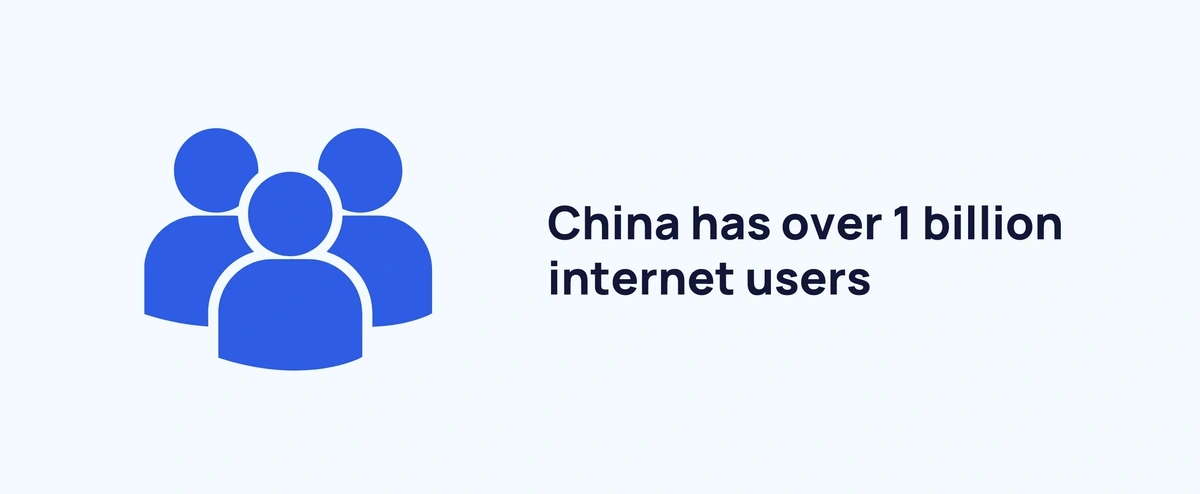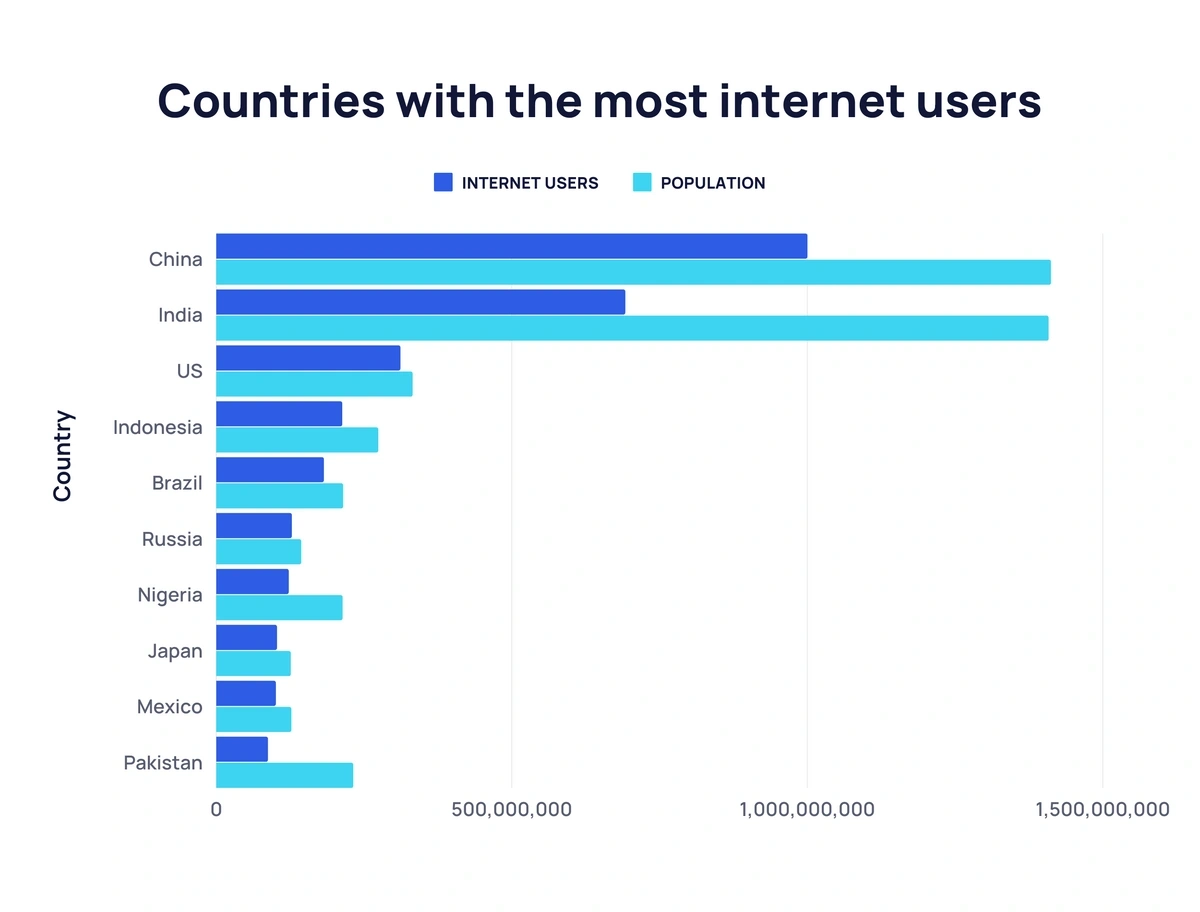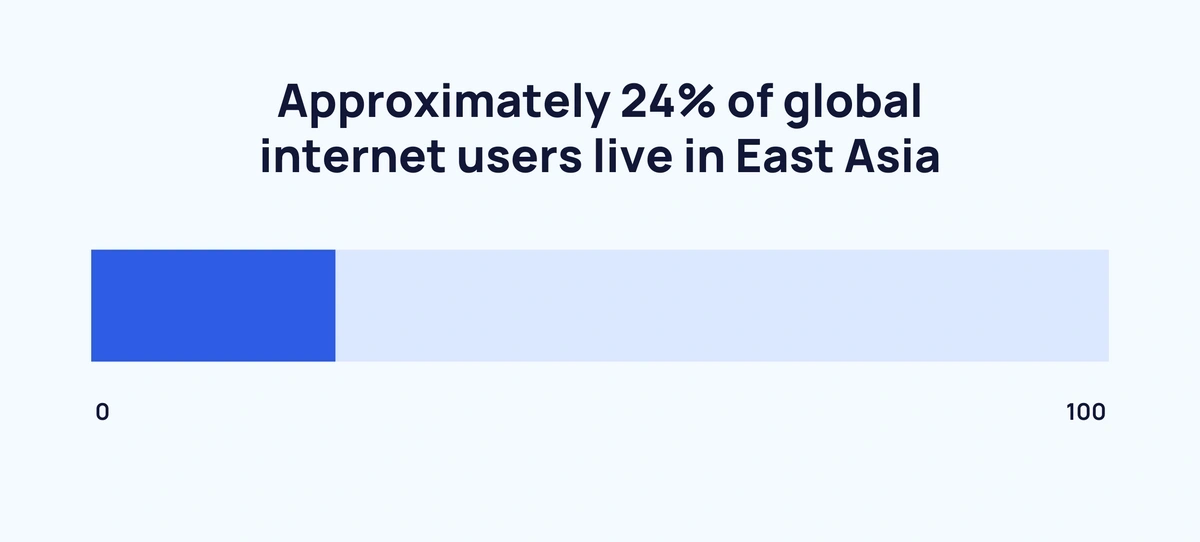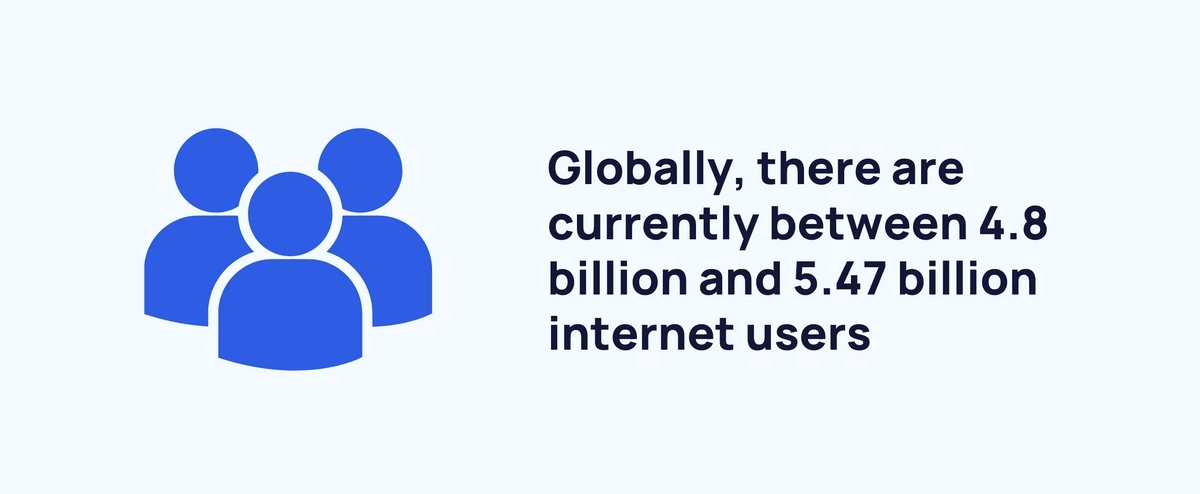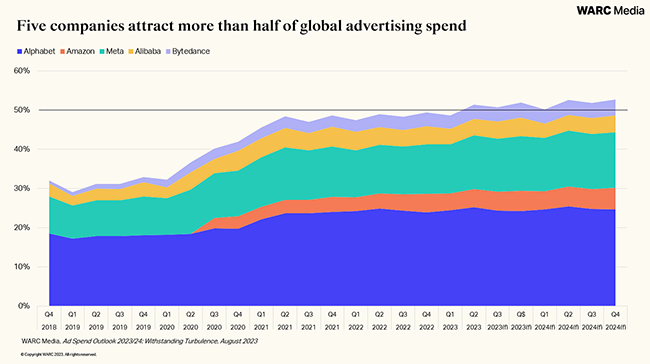Countries with the Highest Number of Internet Users (2024)
The number of internet users around the world continues to grow each year. In general, nations with larger populations are likely to have more internet users, but there are countries that buck the trend.
Below, we’ll dive deeper into the figures and reveal which countries currently have the most internet users.
Contents
- Top International Internet Stats Links to an external site.
- Which Country Has the Most Internet Users? Links to an external site.
- Internet Adoption Statistics by Nation Links to an external site.
- Internet Adoption Statistics by Region Links to an external site.
- Global Internet Users Over Time Links to an external site.
- Unconnected Populations Links to an external site.
- International Internet Use by Device Links to an external site.
Top International Internet Stats
- China has over 1 billion internet users
- More than 90% of Americans use the internet
- Between 59.9% and 68.3% of the global population are online
- 24% of internet users live in East Asia
- Northern Europe has the highest internet penetration rate (97.4%)
- South Africans average a global-high 9 hours 38 minutes per day on the internet
Which Country Has The Most Internet Users?
Perhaps unsurprisingly, given its enormous population, China leads the way for global internet users with an estimated 1.05 billion. Nearly 3 in 4 people (74.36%) in China use the internet.
India currently ranks second with just under half of its population (49.15%) using the internet - that accounts for 692 million people.
The US rounds off the top three with 311.3 million of its 331.9 million population using the internet (93.79%).
|
Rank |
Nation |
Region |
Internet Users |
Population |
Penetration Rate |
|---|---|---|---|---|---|
|
1 |
China |
Asia |
1.05 billion |
1.412 billion |
74.36% |
|
2 |
India |
Asia |
692 million |
1.408 billion |
49.15% |
|
3 |
US |
North America |
311.3 million |
331.9 million |
93.79% |
|
4 |
Indonesia |
Asia |
212.9 million |
273.8 million |
77.76% |
|
5 |
Brazil |
South America |
181.8 million |
214.3 million |
84.83% |
|
6 |
Russia |
Europe/Asia |
127.6 million |
143.4 million |
88.98% |
|
7 |
Nigeria |
Africa |
122.5 million |
213.4 million |
57.41% |
|
8 |
Japan |
Asia |
102.5 million |
125.7 million |
81.54% |
|
9 |
Mexico |
North America |
100.6 million |
126.7 million |
79.4% |
|
10 |
Pakistan |
Asia |
87.35 million |
231.4 million |
37.75% |
|
11 |
Philippines |
Asia |
85.16 million |
113.9 million |
74.77% |
|
12 |
Egypt |
Africa |
80.75 million |
109.3 million |
73.88% |
|
13 |
Vietnam |
Asia |
77.93 million |
97.47 million |
79.95% |
|
14 |
Germany |
Europe |
77.53 million |
83.2 million |
93.19% |
|
15 |
Turkey |
Europe/Asia |
71.38 million |
84.78 million |
84.19% |
|
16 |
Iran |
Asia |
69.83 million |
87.92 million |
79.42% |
|
17 |
Bangladesh |
Asia |
66.94 million |
169.4 million |
39.52% |
|
18 |
UK |
Europe |
66.11 million |
67.33 million |
98.19% |
|
19 |
Thailand |
Asia |
61.21 million |
71.6 million |
85.49% |
|
20 |
France |
Europe |
59.94 million |
67.75 million |
88.47% |
|
21 |
Italy |
Europe |
50.78 million |
59.11 million |
85.91% |
|
22 |
South Korea |
Asia |
50.56 million |
51.74 million |
97.72% |
|
23 |
Spain |
Europe |
45.12 million |
47.42 million |
95.15% |
|
24 |
Argentina |
South America |
39.79 million |
45.81 million |
86.85% |
|
25 |
Poland |
Europe |
36.68 million |
37.75 million |
97.17% |
Source: Data Reportal Links to an external site.
Internet Adoption Statistics By Nation
In total, four countries have an internet adoption rate of 99%:
- Ireland
- Norway
- Saudi Arabia
- UAE
|
Rank |
Nation |
Region |
Internet Adoption |
|---|---|---|---|
|
=1 |
Ireland |
Europe |
99% |
|
=1 |
Norway |
Europe |
99% |
|
=1 |
Saudi Arabia |
Asia |
99% |
|
=1 |
UAE |
Asia |
99% |
|
5 |
Switzerland |
Europe |
98.4% |
|
6 |
Denmark |
Europe |
98.1% |
|
7 |
UK |
Europe |
97.8% |
|
8 |
South Korea |
Asia |
97.6% |
|
9 |
Sweden |
Europe |
97.2% |
|
10 |
Singapore |
Asia |
96.9% |
|
11 |
Malaysia |
Asia |
96.8% |
|
12 |
Australia |
Oceania |
96.2% |
|
13 |
New Zealand |
Oceania |
95.9% |
|
14 |
Netherlands |
Europe |
95.5% |
|
15 |
Spain |
Europe |
94.9% |
|
16 |
Belgium |
Europe |
94.5% |
|
17 |
Austria |
Europe |
94.2% |
|
18 |
Canada |
North America |
93.8% |
|
=19 |
Hong Kong |
Asia |
93.1% |
|
=19 |
Germany |
Europe |
93.1% |
|
- |
World |
- |
64.4% |
Internet Adoption Statistics By Region
Around 1 in 4 (24%) internet users live in East Asia. This heavily populated region has an internet penetration rate of 74.3% - almost 10% higher than the global penetration rate (64.4%).
In fact, Asia is home to the majority of internet users (57.9%).
Northern Europe has the world’s highest internet penetration rate (97.4%).
While East Africa has the lowest internet penetration rate (23.1%).
Here are the global internet users and adoption rates by region in full:
|
Region |
Share of Global Internet Users |
Internet Penetration Rate |
|---|---|---|
|
East Asia |
24% |
74.3% |
|
South Asia |
18.5% |
47.4% |
|
South-East Asia |
10% |
75.6% |
|
South America |
6.8% |
80.6% |
|
North America |
6.7% |
92% |
|
Eastern Europe |
4.9% |
86.9% |
|
West Asia |
4.3% |
75.3% |
|
West Africa |
4% |
48% |
|
Western Europe |
3.5% |
93.5% |
|
North Africa |
3.3% |
65.9% |
|
Southern Europe |
2.6% |
88.4% |
|
Central America |
2.6% |
74.9% |
|
East Africa |
2.1% |
23.1% |
|
Northern Europe |
2% |
97.4% |
|
Central Africa |
1.1% |
27.9% |
|
Central Asia |
1.1% |
72.5% |
|
South Africa |
0.9% |
70.6% |
|
Oceania |
0.7% |
79.4% |
|
Caribbean |
0.6% |
68.4% |
|
World |
100% |
64.4% |
Source: Data Reportal Links to an external site., Statista Links to an external site.
Global Internet Users Over Time
The exact number of global internet users is hard to pinpoint. However, various reliable sources place the figure somewhere between 4.8 billion and 5.47 billion. That means 59.9% to 68.3% of the global population are online.
Here’s the number of internet users according to a few different reputable sources:
|
Source |
Internet Users |
Percentage of Population |
|---|---|---|
|
Internet World Stats |
5.47 billion |
68.3% |
|
ITU |
5.31 billion |
66.3% |
|
CIA World Factbook |
5.05 billion |
63% |
|
World Bank |
4.8 billion |
59.9% |
|
Average |
5.16% |
64.38% |
According to Data Reportal figures, the number of internet users has increased by around 2x since 2013.
Here’s how the global internet user base has grown over the past 11 years:
|
Year |
Internet Users |
Increase Over Previous Year |
|---|---|---|
|
2013 |
2.534 billion |
- |
|
2014 |
2.8 billion |
+10.5% |
|
2015 |
3.004 billion |
+7.3% |
|
2016 |
3.423 billion |
+13.9% |
|
2017 |
3.679 billion |
+7.5% |
|
2018 |
3.977 billion |
+8.1% |
|
2019 |
4.335 billion |
+9% |
|
2020 |
4.627 billion |
+6.7% |
|
2021 |
4.962 billion |
+7.2% |
|
2022 |
5.060 billion |
+2% |
|
2023 |
5.158 billion |
+1.9% |
Source: Data Reportal Links to an external site.
Unconnected Populations
The latest data reveals that there are approximately 2.85 billion who do not use the internet.
While South Asia may have hundreds of millions of internet users, there are also many millions who do not use the internet. It is estimated that South Asia has an unconnected population of 988.7 million – more than double the next largest unconnected regional population (East Asia’s 385.8 million).
|
Rank |
Region |
People Who Do Not Use the Internet |
|---|---|---|
|
1 |
South Asia |
988.7 million |
|
2 |
East Asia |
385.8 million |
|
3 |
East Africa |
360 million |
|
4 |
West Africa |
256.8 million |
|
5 |
South-East Asia |
196.4 million |
|
6 |
Central Africa |
139.4 million |
|
7 |
North Africa |
85.9 million |
|
8 |
South America |
77.2 million |
|
9 |
West Africa |
71.7 million |
|
10 |
Central America |
38.5 million |
|
11 |
Eastern Europe |
33.5 million |
|
12 |
Central Asia |
18.8 million |
|
13 |
South Africa |
18.7 million |
|
14 |
Southern Europe |
14.8 million |
|
15 |
Caribbean |
13.3 million |
|
16 |
North America |
12 million |
|
17 |
Western Europe |
10.8 million |
|
18 |
Oceania |
10.3 million |
|
19 |
Northern Europe |
2.6 million |
|
- |
Global |
2.735 billion |
In terms of nations, the largest unconnected population resides in India. In total, over 680 million Indians do not use the internet – that accounts for 47.6% of the population.
|
Rank |
Nation |
Region |
Unconnected Population |
% of Offline Population |
|---|---|---|---|---|
|
1 |
India |
Asia |
683,707,000 |
47.6% |
|
2 |
China |
Asia |
336,419,000 |
23.6% |
|
3 |
Pakistan |
Asia |
131,801,000 |
54.3% |
|
4 |
Nigeria |
Africa |
123,428,000 |
54.5% |
|
5 |
Ethiopia |
Africa |
103,290,000 |
80.6% |
|
6 |
Bangladesh |
Asia |
96,473,000 |
55.5% |
|
7 |
Indonesia |
Asia |
93,401,000 |
33.5% |
|
8 |
DR Congo |
Africa |
75,612,000 |
72.8% |
|
9 |
Tanzania |
Africa |
46,600,000 |
68.1% |
|
10 |
Uganda |
Africa |
35,946,000 |
73% |
Unsurprisingly, highly-populated nations dominate the top 10 unconnected countries.
However, the list looks very different when focusing on the percentage of unconnected people.
Over 90% of North Korea, South Sudan, and Somalia are offline.
|
Rank |
Nation |
Region |
% of Offline Population |
Unconnected Population |
|---|---|---|---|---|
|
1 |
North Korea |
Asia |
>99.9% |
No data |
|
2 |
CAR |
Africa |
89.4% |
5,210,000 |
|
3 |
Burundi |
Africa |
88.7% |
11,901,000 |
|
4 |
South Sudan |
Africa |
87.9% |
8,823,000 |
|
5 |
Niger |
Africa |
83.1% |
23,016,000 |
|
6 |
Yemen |
Asia |
82.3% |
28,666,000 |
|
7 |
Afghanistan |
Asia |
81.6% |
34,927,000 |
|
8 |
Ethiopia |
Africa |
80.6% |
103,290,000 |
|
9 |
Burkina Faso |
Africa |
80.1% |
18,853,000 |
|
10 |
Madagascar |
Africa |
79.4% |
24,373,000 |
Source: Data Reportal Links to an external site.
International Internet Use By Device
With an average time of 9 hours and 24 minutes of daily internet use, South Africans spend the most time online per day.
Not far behind, Brazil, the Philippines, Colombia, and Argentina each average over 9 hours of internet use per day.
Below are the top nations by average daily time spent using the internet:
|
Country |
Average Daily Time Spent Using the Internet |
|---|---|
|
South Africa |
9 hours 24 minutes |
|
Brazil |
9 hours 13 minutes |
|
Philippines |
8 hours 52 minutes |
|
Colombia |
8 hours 43 minutes |
|
Argentina |
8 hours 41 minutes |
|
Chile |
8 hours 31 minutes |
|
Russia |
8 hours 21 minutes |
|
Malaysia |
8 hours 17 minutes |
|
UAE |
8 hours 11 minutes |
|
Thailand |
7 hours 58 minutes |
|
Worldwide |
6 hours 40 minutes |
Mobile
According to the latest data, 56.9% of internet access comes from mobile devices Links to an external site.. While 43.1% of internet use comes from computers.
Filipinos spend an average of 5 hours and 20 minutes using mobiles to access the internet each day – that’s 1 hour and 30 minutes more than the global average.
|
Country |
Average Daily Time Spent Using the Internet on Mobile |
|---|---|
|
Philippines |
5 hours, 20 minutes |
|
Brazil |
5 hours, 19 minutes |
|
South Africa |
5 hours, 15 minutes |
|
Thailand |
5 hours, 2 minutes |
|
Ghana |
4 hours, 58 minutes |
|
Chile |
4 hours, 48 minutes |
|
Colombia |
4 hours, 47 minutes |
|
Indonesia |
4 hours, 45 minutes |
|
Argentina |
4 hours, 37 minutes |
|
Malaysia |
4 hours, 37 minutes |
|
Worldwide |
3 hours, 50 minutes |
According to recent data, all (98.9%) adults aged 18 to 64 access the internet via a smartphone in Indonesia.
The global average for accessing the internet via a smartphone sits at 96.5%.
|
Country |
% of Population Who Access the Internet via a Smartphone |
|---|---|
|
Indonesia |
98.9% |
|
Philippines |
98.8% |
|
South Africa |
98.7% |
|
Brazil |
98.5% |
|
Thailand |
98.3% |
|
Turkey |
98.2% |
|
Colombia |
98% |
|
Malaysia |
97.9% |
|
Mexico |
97.6% |
|
Chile |
97.4% |
|
Worldwide |
96.5% |
Computer
No country averages more time spent accessing the internet via a computer than Russia (4 hours and 24 minutes). That figure equates to 1 hour and 34 minutes more than the global average of 2 hours and 50 minutes.
|
Country |
Average Daily Time Spent Using the Internet on Computer |
|---|---|
|
Russia |
4 hours, 24 minutes |
|
South Africa |
4 hours, 9 minutes |
|
Argentina |
4 hours, 5 minutes |
|
Portugal |
3 hours, 57 minutes |
|
Colombia |
3 hours, 56 minutes |
|
Brazil |
3 hours, 54 minutes |
|
Chile |
3 hours, 42 minutes |
|
Bulgaria |
3 hours, 40 minutes |
|
Malaysia |
3 hours, 40 minutes |
|
UAE |
3 hours, 38 minutes |
|
Worldwide |
2 hours, 50 minutes |
The vast majority (86.5%) of people living in Czechia access the internet via a computer.
In total, 7 of the top 10 nations for populations who access the internet via computer are situated in Europe.
|
Country |
% of Population Who Access the Internet via a Computer |
|---|---|
|
Czechia |
86.5% |
|
Croatia |
86.1% |
|
Portugal |
84.5% |
|
Poland |
84.3% |
|
Switzerland |
83.4% |
|
Austria |
82.5% |
|
Canada |
81.2% |
|
South Africa |
81.1% |
|
Belgium |
81% |
|
New Zealand |
79.8% |
|
Worldwide |
61.8% |
Source: Data Reportal Links to an external site.
Conclusion
Given the gap between China’s number of internet users and second-placed India’s internet users is larger than any other country’s total population, a change in the top spot is unlikely to occur any time soon.
With that, Asia as a continent will continue to lead the way in terms of internet users as the global figure continues to grow.
For more internet-related statistics, take a look at these other blog posts: Alarming Average Screen Time Statistics Links to an external site. and Amount of Data Created Daily Links to an external site..
Article #2
WASHINGTON (AP) — Someone in China created thousands of fake social media accounts designed to appear to be from Americans and used them to spread polarizing political content in an apparent effort to divide the U.S. ahead of next year’s elections, Meta Links to an external site. said Thursday.
The network of nearly 4,800 fake accounts was attempting to build an audience when it was identified and eliminated by the tech company, which owns Facebook and Instagram. The accounts sported fake photos, names and locations as a way to appear like everyday American Facebook users weighing in on political issues.
Instead of spreading fake content Links to an external site. as other networks have done, the accounts were used to reshare posts from X, the platform formerly known as Twitter, that were created by politicians, news outlets Links to an external site. and others. The interconnected accounts pulled content from both liberal and conservative sources, an indication that its goal was not to support one side or the other but to exaggerate partisan divisions and further inflame polarization.
The newly identified network shows how America’s foreign adversaries exploit U.S.-based tech platforms to sow discord and distrust, and it hints at the serious threats posed by online disinformation next year, when national elections will occur in the U.S., India, Mexico, Ukraine, Pakistan, Taiwan and other nations.
“These networks still struggle to build audiences, but they’re a warning,” said Ben Nimmo, who leads investigations into inauthentic behavior on Meta’s platforms. “Foreign threat actors are attempting to reach people across the internet ahead of next year’s elections, and we need to remain alert.”
Meta Platforms Inc., based in Menlo Park, California, did not publicly link the Chinese network to the Chinese government, but it did determine the network originated in that country. The content spread by the accounts broadly complements other Chinese government propaganda and disinformation Links to an external site. that has sought to inflate partisan and ideological divisions within the U.S.
To appear more like normal Facebook accounts, the network would sometimes post about fashion or pets. Earlier this year, some of the accounts abruptly replaced their American-sounding user names and profile pictures with new ones suggesting they lived in India. The accounts then began spreading pro-Chinese content about Tibet and India, reflecting how fake networks can be redirected to focus on new targets.
Meta often points to its efforts to shut down fake social media networks as evidence of its commitment to protecting election integrity and democracy. But critics say the platform’s focus on fake accounts distracts from its failure to address its responsibility for the misinformation already on its site that has contributed to polarization and distrust Links to an external site..
For instance, Meta will accept paid advertisements on its site to claim the U.S. election in 2020 was rigged or stolen, amplifying the lies of former President Donald Trump Links to an external site. and other Republicans whose claims about election irregularities have been repeatedly debunked Links to an external site.. Federal and state election officials and Trump’s own attorney general have said there is no credible evidence that the presidential election, which Trump lost to Democrat Joe Biden Links to an external site., was tainted.
When asked about its ad policy, the company said it is focusing on future elections, not ones from the past, and will reject ads that cast unfounded doubt on upcoming contests.
And while Meta has announced a new artificial intelligence policy Links to an external site. that will require political ads to bear a disclaimer if they contain AI-generated content, the company has allowed other altered videos that were created using more conventional programs to remain on its platform, including a digitally edited video of Biden that claims he is a pedophile.
“This is a company that cannot be taken seriously and that cannot be trusted,” said Zamaan Qureshi, a policy adviser at the Real Facebook Oversight Board, an organization of civil rights leaders and tech experts who have been critical of Meta’s approach to disinformation and hate speech. “Watch what Meta does, not what they say.”
But 2024 poses new challenges, according to experts who study the link between social media and disinformation. Not only will many large countries hold national elections, but the emergence of sophisticated AI programs means it’s easier than ever to create lifelike audio and video that could mislead voters.
“Platforms still are not taking their role in the public sphere seriously,” said Jennifer Stromer-Galley, a Syracuse University professor who studies digital media.
Stromer-Galley called Meta’s election plans “modest” but noted it stands in stark contrast to the “Wild West” of X. Since buying the X platform Links to an external site., then called Twitter, Elon Musk has eliminated teams focused on content moderation, welcomed back many users previously banned for hate speech Links to an external site. and used the site to spread conspiracy theories Links to an external site..
Democrats and Republicans have called for laws addressing algorithmic recommendations, misinformation, deepfakes and hate speech, but there’s little chance of any significant regulations passing ahead of the 2024 election. That means it will fall to the platforms to voluntarily police themselves.
Many of the fake accounts identified by Meta this week also had nearly identical accounts on X, where some of them regularly retweeted Musk’s posts.
Those accounts remain active on X. A message seeking comment from the platform was not returned.
Meta also released a report Wednesday evaluating the risk that foreign adversaries including Iran Links to an external site., China and Russia Links to an external site. would use social media to interfere in elections. The report noted that Russia’s recent disinformation efforts Links to an external site. have focused not on the U.S. but on its war against Ukraine Links to an external site., using state media propaganda and misinformation in an effort to undermine support for the invaded nation.
Nimmo, Meta’s chief investigator, said turning opinion against Ukraine will likely be the focus of any disinformation Russia seeks to inject into America’s political debate ahead of next year’s election.
“This is important ahead of 2024,” Nimmo said. “As the war continues, we should especially expect to see Russian attempts to target election-related debates and candidates that focus on support for Ukraine.”
